|
Breast Color Genetics
Gouldians come in three recognized breast colors:
Purple
Lilac
White
These traits can be understood as different "alleles" of one gene. Meaning - breast color is defined by one gene, and there are three different alleles (read: varieties) available - one for Purple, one for Lilac and one for White. This means that no bird can ever be triply split for each allele. i.e., no purple/white/lilac bird will ever exist!
Purple Breast:
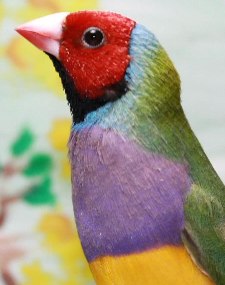 |
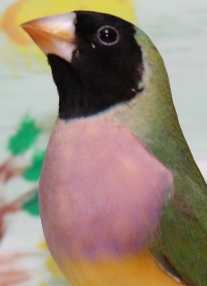 |
| PB Cock |
PB Hen |
Purple breast is an autosomal dominant trait to both lilac and white. Cocks and hens can both be SF or DF for Purple breast. However, a bird that possesses at least one copy of the purple allele will always be visually purple breasted. The only way to know if your bird is split for lilac or white is by test breeding it to a lilac or white bird - if you get lilac or white babies, you know your bird is split! Purple breasted birds occur in all body color mutations.
Lilac Breast:
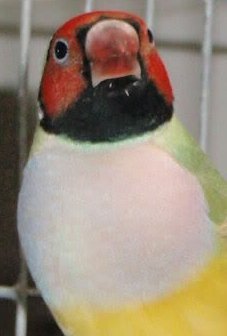 |
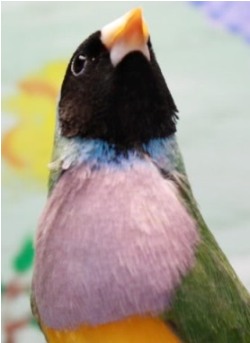 |
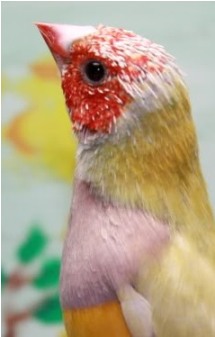 |
| LB Hen |
LB Normal Cock |
RH LB SF Yellow Cock |
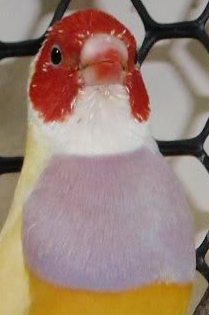 |
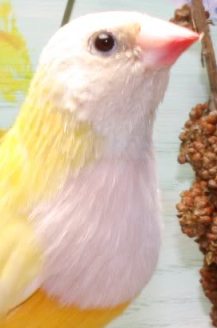 |
| RH LB DF Yellow Cock |
BH LB DF Yellow Cock |
Lilac breast is recessive to Purple but dominant to White. A bird that is visually Lilac Breast will either be DF Lilac or Lilac/White. The Lilac breast color is interesting particularly in males due to the variation of Lilac color seen. This appears to be directly related to the amount of melanin reduction in males. That is to say, a normal bodied male that is LB will have the darkest Lilac color. A SF Yellow male that is RH will be slightly lighter, DF Yellow RH males even lighter, and BH DF Yellow males being the lightest lilac.
White Breast:
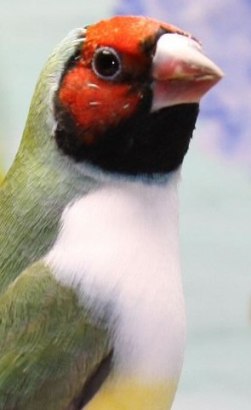 |
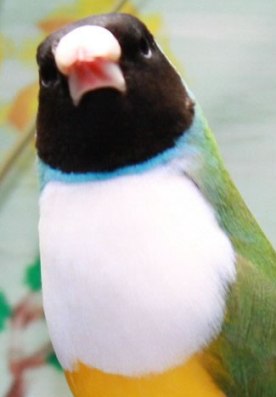 |
| WB Hen |
WB Cock |
White breast is recessive to both Purple and Lilac. The only way a bird will be visually white breasted is if it is DF for the White allele (no visually WB bird will be "split" for any of the other two breast colors).
Breast Color Pairings and Results
The following will try to break down some of the possible genetic results of the following breedings. This is only discussing breast color and is not taking body or head color into consideration. The cock and hen pairings will be listed at the top in bold, with the possible outcomes below.
Breast Color: You should remember from our genetics discussion that breast color is an autosomal trait. This means both cocks and hens can be split for Lilac or White - or DF/SF for Purple (no bird can be split for purple as it is dominant over the other alleles). Because of this, I will focus mainly on inter-breast color pairings - because anytime a purple gene is present, it is going to be expressed (thus a DFPB x SFPB pairing will always result in visually purple breasted birds).
| PB Cock x PB Hen |
| PB Cocks |
PB Hens |
| PB Cock x LB Hen (or vice-versa) |
| All of the babies would be PB/LB |
To save time here - note that in a pairing of a PB bird with a WB bird, the outcome would be the same - all babies would be PB/WB. Similarly, a pairing of a LB bird with a WB bird would produce all babies that are LB/WB.
| PB/WB Cock x WB Hen (or vice-versa) |
| 50% PB/WB babies |
50% WB babies |
The results of this pairing would be similar for LB/WB with a WB bird - 50% being LB/WB, the other 50% being WB.
| PB/WB Cock x PB/WB Hen |
| 25% DFPB Birds |
| 50% PB/WB Birds |
| 25% WB Birds |
These results would be similar for a LB/WB x LB/WB pairing - with the results being 25% LB; 50% LB/WB and 25% WB.
With the recessive breast colors, a similar logic follows in terms of breeding two different heterozygotes ("splits") together - you will not be able to distinguish birds that are DF versus birds that are split for the recessive trait, and in the case of two different heterozgotes, you'd have no idea what the offspring were split for. For example, if you paired a PB/LB with a LB/WB bird, the results would be 25% PB; 25% PB/LB; 25% PB/WB; and 25% LB/WB. The only bird(s) you'd be able to visually identify and know their genetics would be the LB/WB which is the only birds you'd have that would not appear Purple Breasted. |